
How Do Braces Fix Crossbites?
By Dr. Tyler Coles – Premier Orthodontics
Table of Contents
When it comes to teeth, you have probably heard of crossbites. But chances are you don’t fully understand what a crossbite is or how braces can fix crossbites.
In this article, we’re going to show you, in detail and with many examples, the different types of crossbites. We’ll also show how each type of crossbite is corrected with braces or other means. We will even show you before and after photos of actual patients who received crossbite correction – that way there’s no mystery around the process.
What Is A Crossbite?
Before we start talking about how to fix crossbites, let’s first define what a crossbite is, as well as the different types…
There are three different types of crossbites. These include:
- A Posterior Crossbite
- An Anterior Crossbite
- A Buccal Crossbite
Never heard of these before? No problem! We’ll describe each type of crossbite below, and show examples.
What is a Posterior Crossbite?
The word “posterior” means further back in position. So a posterior crossbite is a crossbite that occurs on the back teeth. In cases of posterior crossbite, the upper teeth will be more narrow than the lower teeth.
Ideally the upper teeth should be wider than the bottom teeth and should sit outside of the lower teeth. This image below is a good example of how we want the back teeth to sit:
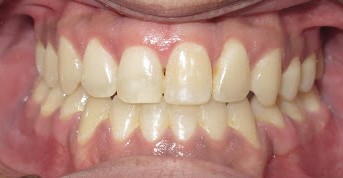
Now let’s look at an example of a posterior crossbite, where the upper teeth sit inside of the lower teeth:
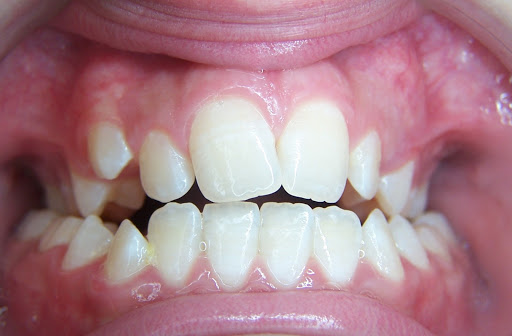
In this picture, both sides of the upper arch fit inside of the bottom teeth. This is called a “bilateral posterior crossbite” because it is a crossbite that occurs on both sides.
Another type of posterior crossbite is when just one side of the upper arch falls inside of the lower teeth. This is called a “unilateral posterior crossbite.” The picture below is a good example:
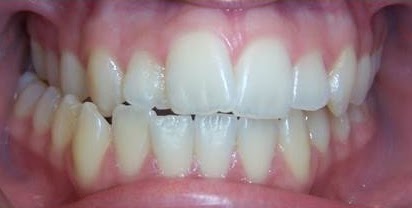
This picture shows that the teeth on the right side sit entirely inside of the lower arch.
Now that we’ve defined what a posterior crossbite is, let’s discuss anterior crossbites.
What is an Anterior Crossbite?
The word “anterior” means nearer to the front in position. So an anterior crossbite is a crossbite that occurs on the front teeth, when one or more of the top teeth fall inside of the bottom teeth.
The pictures below are a good example of a single-tooth anterior crossbite.

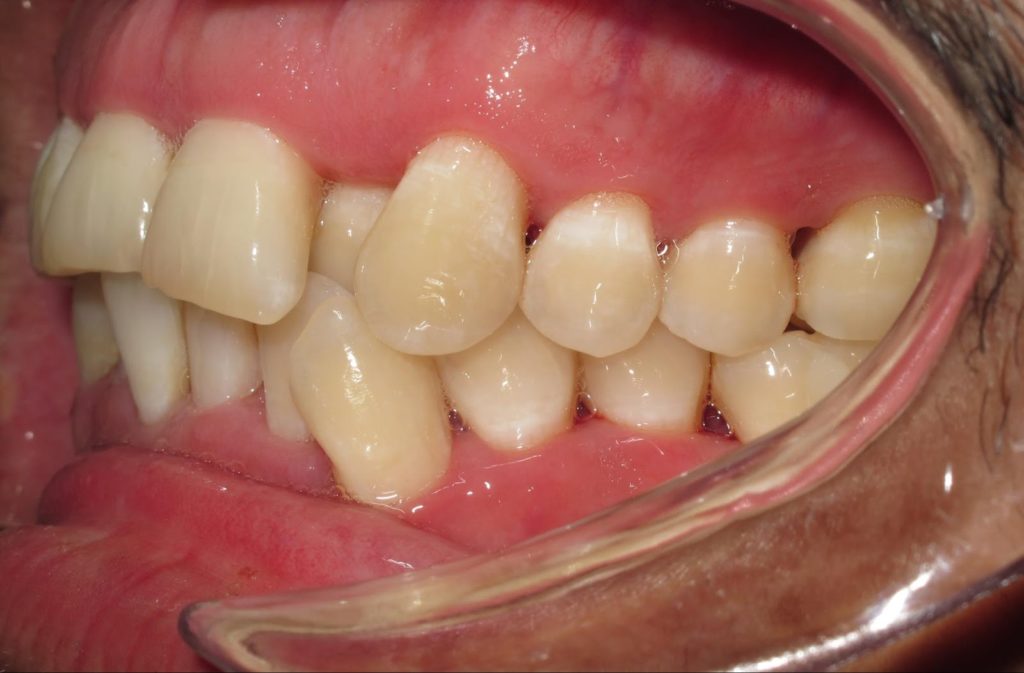
You can see that just one tooth on the upper arch falls behind the teeth on the lower arch.
Another type of anterior crossbite is where multiple teeth sit behind the lower teeth. This is sometimes called an underbite. This patient here is a good example:
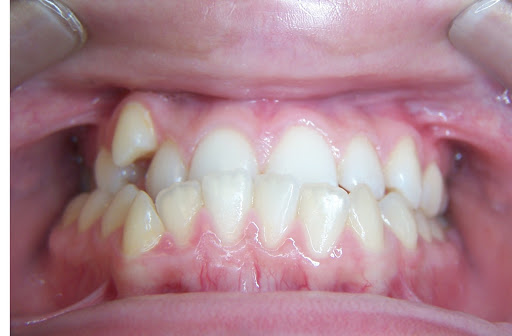
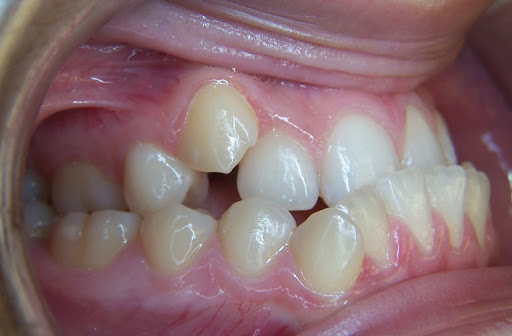
Both single-tooth anterior crossbites, and underbites are defined as “anterior crossbites” because they occur with the front teeth.
What is a Buccal Crossbite?
The word “buccal” means relating to the cheek. So a buccal crossbite (sometimes referred to as a “Scissor Bite”) is when the back teeth sit entirely outside of the lower arch, and sit too close to the cheek.
The picture below is a good example of a buccal crossbite.
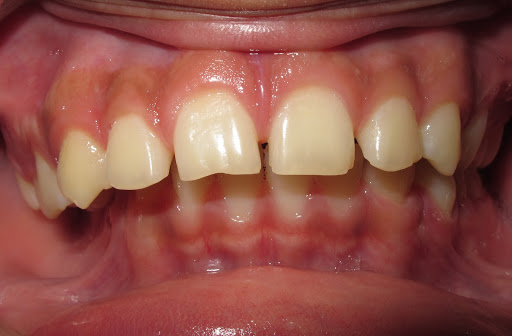
You can see that this patient’s back teeth on the right side sit entirely outside of the lower arch, and don’t bite against the lower teeth at all.
Why Are Crossbites a Problem?
So why do you need to fix a crossbite? Aside from the fact that crossbites don’t look great cosmetically, they can also cause some significant tooth and jaw problems over time.
Crossbites can cause:
- A traumatic bite leading to chipped and damaged teeth
- Asymmetric jaw growth
- TMJ and jaw joint problems
- Restricted airways leading to snoring and other sleep problems
When is the Best Time to Fix a Crossbite?
Not only can crossbites become physically uncomfortable if left untreated, but they often get more difficult to fix as one gets older.
Crossbites, including posterior crossbites, anterior crossbites and buccal crossbites, should be fixed as soon as possible. Orthodontists prefer to fix these types of problems as early as age seven in growing children, however Invisalign or braces can still be used to correct crossbites in adults.
If you think you or your child may have a crossbite it is recommended that they be evaluated by an orthodontist right away.
How a Posterior Crossbite is Fixed
In this next section, we’ll discuss specific treatments for posterior crossbites. Then you’ll get to see before-and-after photos of patients who had posterior crossbite correction in our office.
Fixing a Mild Posterior Crossbite With Elastics and Braces
If a patient has a mild posterior crossbite, they may be treated with a combination of braces and elastics. This type of treatment usually works best when only a single tooth is in a crossbite. The patient below is a good example:
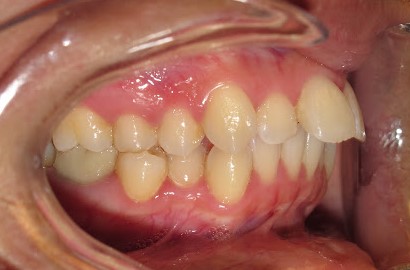
Watch the animation below to see how braces and rubber bands can help fix a mild posterior crossbite.
The video shows the elastic band gradually expanding the upper teeth while simultaneously constricting the lower teeth.
The patient shown in the previous photos was treated with braces and crossbite elastics, and you can see that this strategy was effective by comparing the before-and-after photos.
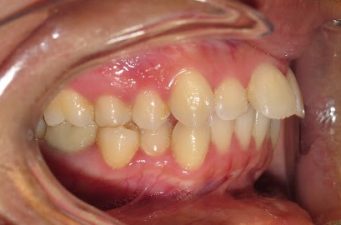
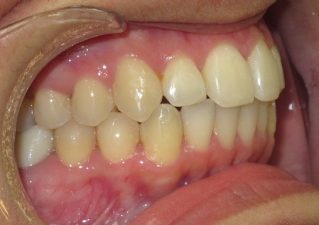
This type of treatment is effective in patients who don’t have a severe posterior crossbite and only need a minor correction.
Fixing a Moderate Posterior Crossbite With a Quad Helix Expander
If a patient has a more serious posterior crossbite, a combination of braces and a quad helix expander may be needed. The patient below is a good example of a moderate posterior crossbite:
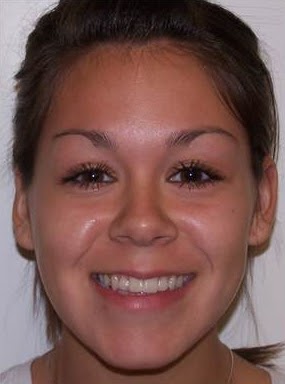

This patient has a “unilateral” posterior crossbite, or a crossbite that occurs just on one side. These types of crossbites can often be treated with a combination of braces and a quad helix expander.
This type of expander can be used with young children, teens, and adults.
Watch the animation below to see how a Quad Helix Expander can help correct a posterior crossbite.
The patient example discussed earlier received a combination of braces and a quad helix expander. You can see from her before-and-after photos that she was able to get full correction of her posterior crossbite by expanding the upper teeth.


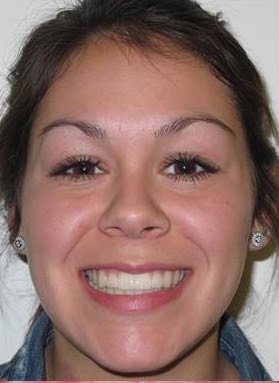
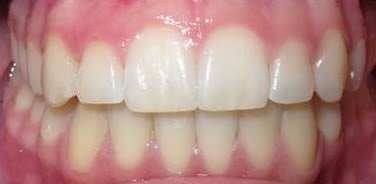
Fixing a Severe Posterior Crossbite With a Rapid Palatal Expander (RPE)
If a patient has a severe crossbite, a combination of braces and a Rapid Palatal Expander (RPE) may be needed. This type of expander expands both the teeth on the upper arch and the palatal bones. This type of expander is usually used only in young children and in growing teenagers. Since this appliance is designed to expand the bones of the palatal, it can only be done successfully within that age range.
The patient below is a good example of a severe posterior crossbite that would benefit from a rapid palatal expander:

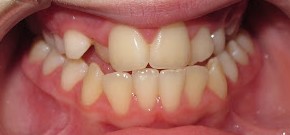
The patient from these photos has a “bilateral” posterior crossbite, or a crossbite that occurs on both sides. These types of crossbites are usually best treated with a combination of braces and a rapid palatal expander
Watch the animation below to see how a Rapid Palatal Expander (RPE) can help correct a posterior crossbite.
The patient shown above received a combination of braces and a Rapid Palatal Expander. Notice in her before-and-after photos that she was able to get full correction of her posterior crossbite by expanding the upper arch.



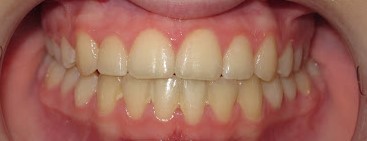
How to Fix an Anterior Crossbite
In this next section, we’ll discuss specific treatments for anterior crossbites and show before-and-after photos of patients who had anterior crossbite correction.
Fixing a Single Tooth Anterior Crossbite Braces and Bite Pads
If a patient has a single tooth anterior crossbite, they can usually be treated with a combination of braces and bite pads.
This patient below is a good example of a single tooth anterior crossbite:


You can see that just one tooth on the upper arch sits behind the teeth on the lower arch. With the bite in its current position, it would not be possible to place brackets on the upper teeth without the lower teeth biting down on the brackets.
In order to bring this single tooth forward over top of the bottom teeth with braces, we would need to prop open the bite by placing bite pads on the back teeth.
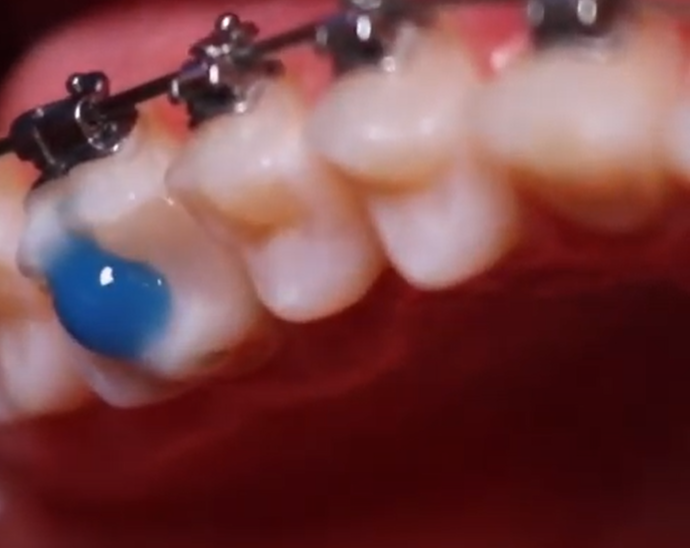
What are bite pads? They are small mounds of dental composite, usually blue in color, that props the bite open and allows the teeth to move forward.
These bite pads will typically be placed at the same time as braces; they are removed once the bite is corrected.
With the patient shown below, you can see that braces with bite pads helped to align his teeth,correct the anterior crossbite and improve the look and health of his mouth.
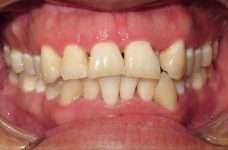
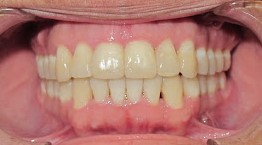
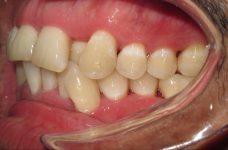
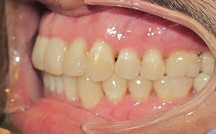
Fixing a Multiple Tooth Anterior Crossbite (Underbite)
If a patient has multiple anterior teeth in a crossbite, this is usually called an underbite.
This patient below is a good example of a multiple tooth anterior crossbite:


There are many different types of underbite treatment, and we discuss these different treatment options in length in our How Do Braces Fix Underbites article.
Fixing a Combination of a Posterior Crossbite and an Anterior Crossbite
While there are three distinct types of crossbites, some patients may have a combination or overlap of crossbite types. For example, the patient below has both anterior and posterior crossbites at the same time:
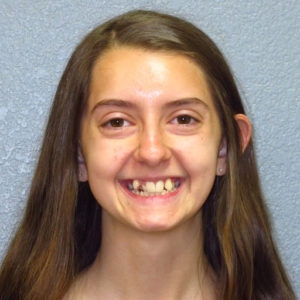
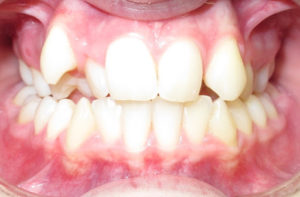
You can observe from the photos that the back teeth are too narrow compared to the lower teeth (posterior crossbite) and one of the front teeth is sitting behind the lower teeth (anterior crossbite).
A combination of a Rapid Palatal Expander (RPE),braces and bite pads is needed to correct both the posterior and anterior crossbites.
You can observe from the pictures below that the patient was able to get full bite correction and got a great result.



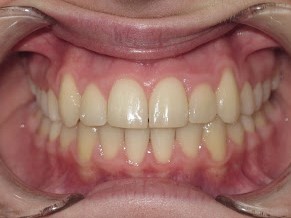
How to Fix a Buccal Crossbite
In this section we’ll discuss specific treatments for buccal crossbites, also known as scissor bites or brodie bites.
This type of crossbite is not very common, but it is one that orthodontists see from time to time.
This patient below is a good example of buccal crossbite:
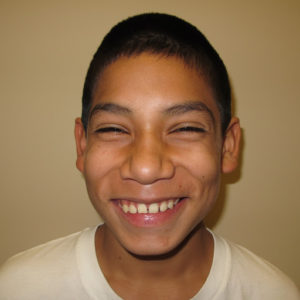
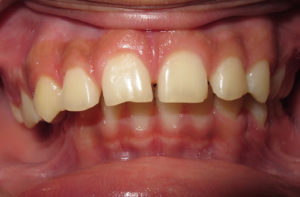
You can see that the entire upper arch on the right side sits outside of the lower arch.
In order to correct buccal crossbites, a combination of braces and elastics are needed to help to expand the lower arch and constrict the upper arch. This is best visualized by watching the animation below:
With the patient we showed earlier, a combination of braces and elastics were used to get full correction of the buccal crossbite.


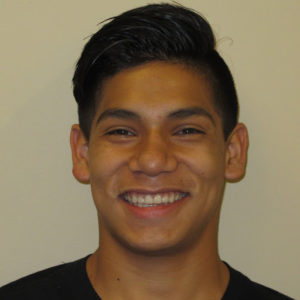
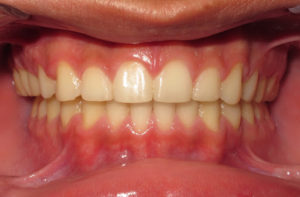
How Can I Tell if Me or My Child Needs to Fix a Crossbite?
If you think you or your child may need braces to correct a crossbite, the best place to start is by getting a free consultation with an orthodontist in your area.
Braces in Phoenix, Chandler, Maricopa, and Casa Grande
Premier Orthodontics has 6 locations providing braces and Invisalign in Phoenix, Chandler, Gilbert, Maricopa, Casa Grande, and Glendale as well as the surrounding areas.
Schedule your free consultation for braces or Invisalign or read our comprehensive guide to the cost of braces . (We are very transparent about our process and our pricing, as you’ll see in this guide.)
Schedule a Free Braces Consultation For You or Your Child
Thinking about getting started with braces?
You can schedule a 100% free consultation and find out if clear braces the best choice for you.
Whether you’re thinking about braces for kids, braces for an adult, or even Invisalign, we’ve got you covered!
Click below to learn how you can get started with braces for as low as $89/month.


